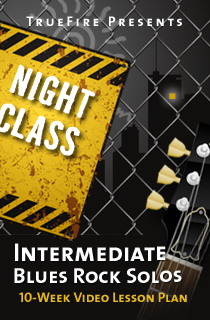Night Classes are ten-week TrueFire guitar lesson plans that build on basic concepts and techniques from TrueFire courses. Intermediate Blues Rock Solos uses guitar lessons from the courses of Jeff Scheetz and Joe Deloro to offer a bevy of tips and tricks to take your blues rock solos to the next level.
Welcome to week one of Intermediate Blues Rock Solos, the TrueFire guitar lesson plan featuring two videos from Jeff Scheetz’ Rock Solid course. This guitar lesson plan features an obvious Stevie Ray Vaughan influence, exemplified by Jeff’s raw guitar sound. To achieve this sound, Jeff plays a Strat with a Texas Special pickup in the neck position through a Hughes & Kettner Tube Factor pedal for some edge into a modded blackface late-seventies Fender Twin, mic’d with a Shure SM 57. Pretty straightforward, but if you want a raw sound you gotta use a raw setup!
This solo is based on the D minor pentatonic scale, starting in the first blues position at the tenth fret. It moves when adding notes from other sources, most notably when outlining a C9 arpeggio. Although they can be a bit tedious to study at times, a thorough understanding of arpeggio shapes and patterns is integral to implementing them effectively, as Jeff does here.
Read on for the full guitar lesson…
Performance
Pay attention as Jeff jumps to the C7/C9 arpeggio in bar five. He outlines the chord, which is simply an open position C7 shape moved up 12 frets, to create a fresh sound. We’ve seen this progression before in Blues Rock Solos 101. It’s a vamp on the I chord, going to the chord two frets lower, or one whole note. In this case, we move between a D7 and a C7. The C7 can be thought of as the b7th of the D scale.
The solo is split into two eight bar sections. Jeff starts the second with a rest while changing positions. Study his fingering as he moves from the lower to the higher position on the neck. The use of slides to move through scale positions is a great way to access the entire fretboard.
Breakdown
Most of the licks are out of the first blues position of D, except for the licks over the C7 chord. By accenting the chord tones of the C7 or any of the chords from that family, such as C9 or C13, the licks over this chord really jump out.
Although you could rely on the D minor pentatonic scale for both chords, the color of this progression is really brought out by taking the chord you are playing over into account. To do this effectively, you need to know the individual chord tones and be able to play the chord’s arpeggio in different positions. The first lick Jeff plays over the C7 demonstrates this approach.
Jeff also incorporates different forms of vibrato which would be a great reference to get that technique together.
Practice Regimen For Week 1
Day 1: Dial up a raw sound and play all of the D minor pentatonic scale positions you know. You should be familiar with a minimum of two: the first position with the index finger starting on the tonic D on the sixth string at the tenth fret, and the second position with the root fretted by the index finger at the 12th fret of the fourth string. Play with the jam track from this week and jam using these two positions. Use licks that move from one position to the next. Also, incorporate bends, slides, hammer-ons and pull-offs. Finish today by watching Jeff’s performance on video one.
Day 2: Print the chart with tab of the solo and study it. Focus on the licks Jeff plays over the C7. Find the C7 chord tones he uses and play around with them. If needed, chart them out. Next, do this again for the C7 arpeggio that starts on the eighth fret of the sixth string – find the chord tones and tab them out. Play the jam track and solo over it. Focus on the different forms of vibrato Jeff demonstrates in the video. Play a short lick, using vibrato on the last note of the phrase. It should be played with even up and down movement, and should start slowly, increasing in speed while the note continues to sustain.
Day 3: Watch video two, then study the individual licks. Jeff bends a string, then adds vibrato to the bent note. This is a challenging technique; take a few minutes to practice it. Study the positions Jeff uses and improvise on the jam track focusing on bends and vibrato.
Day 4: Jeff plays the second part of the solo starting in the fifth blues position, gradually sliding up to the first and second positions. Study this technique as he slides up on the fifth and the third strings. Crank up the jam track and improvise using this sliding blues scale to move from one position to another. Improvise over the jam track again, making a clear distinction in what you play over the D7 and C7 chords. Begin by using the D blues scale over the D7 chord and chord tones for the C7.
Day 5: Play this week’s solo with the jam track:
http://truefire.com/rock-guitar-lessons/rock-solid/beggarss.mp3
Night Classes are ten-week TrueFire guitar lesson plans that build on basic concepts and techniques from TrueFire courses. Intermediate Blues Rock Solos uses guitar lessons from the courses of Jeff Scheetz and Joe Deloro to offer a bevy of tips and tricks to take your blues rock solos to the next level.
